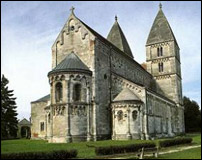Architecture
Hungary is perhaps best known for its architecture and cultural heritage.
Visitors may find themselves traveling several hundred years back in time standing on a single street corner or visiting one of Hungary’s most admired sites.
Hungary architecture was greatly influenced by the Romanesque and the gothic styles.
The beautiful monuments in Hungary stand as an epitome of Hungarian Architecture.
These monuments, buildings, churches, palaces and museums have distinct style of their own.
Some of them have been ruined with the time, but the restored monuments are major places of attractions for tourists.
Within the often changing borders of Hungary during its history, fine arts have been developed in strong interaction with European art and although they always reflected European tendencies, they retained a strong character of their own.

The first important architectural works following the Hungarian Conquest began at the turn of the 10th and 11th centuries with the construction of the Benedictine Pannonhalma Archabbey.
This is the oldest historical monument in Hungary.
It was founded as the first Hungarian Benedictine monastery in 996 by prince Geza, who designed this as a place for the monks to settle, and then soon after became the centre of Benedictine order.
The monastery was built in honor of Saint Martin of Tours.
Geza’s son, King Stephen I donated estates and privilege to the monastery.
Astrik (Anastasius) served as its first abbot.

The royal basilica was also built during the same period in Szekesfehervar and served as a coronation and burial site.
It was founded by Saint Stephen king and at the time, it was one of the biggest basilicas in Europe.

The most Romanesque style buildings were inherited from the 13th century.
Example; the Benedictine abbey Jak and Lebeny, or the Premontre monastery church of Zsambek

After the Tatar incursions of 1241-42, Bela IV encouraged the construction of stone castles to enhance defenses.
The first royal residence on Castle Hill was built by King Bela IV between 1247 and 1265.
During the reign of Bela IV, Saint Stephen church was rebuilt and officially named as the Church of Our Lady.
Most Hungarians know this site as Matthias Church - built in the gothic style.

The architecture of the first half of the 14th century displays the influence of French late classical gothic and Italian Trecento.
The most beautiful memory of Gothic style was Hunyad Castle, which was restored between 1446 and 1453.
It has both Gothic and Renaissance architectural elements.

The architecture under King Matthias in the 15th century displayed a late gothic influence of the Italian Renaissance, which can be sensed at Visegrad and Buda Castle.

Constant war in 16th century ensured the importance of castles such as Castle of Eger.
Christian churches were modified under the 150 years of Turkish rule and mosques were either constructed or Christian churches converted to mosques.
You can still see the Turkish influence in key cities of Hungary today.

Traces of 17th and 18th century baroque have remained practically everywhere.
Palace Eszterhaza and University of Eger are buildings from this period and are some of the more famous Hungarian monuments.
After the Turks were defeated, Hungarian ecclesiastical architecture gained popularity.
Several of the castles and palaces throughout Hungary were rebuilt.

In the 19th century the architectural emphasis turned increasingly to secular buildings and homes.
At the beginning of the century, a variety of classicism representing Western Europe main style, are visible.
The buildings were characterized in moderate puritan style.
Mansions, row houses, public buildings began to increase.
The first major building in this time was designed by Mihály Péchy, the Great Church of Debrecen.
In the same era was built the Hungarian National Museum by Mihály Pollack, which is also important neoclassical building in European context.

The Neo-Gothic Parliament building is one of the city's most decorative structures, characterized by numerous small spikes and stone lace ornamentation.
With its magnificent staircase and exquisite reception rooms, the parliament is one of the largest assemblies in the world.

The Palace of the Hungarian Academy of Sciences was built in 1865 and is one of the finest examples of Neo-Renaissance style.
The building's facade is part of the image of the city and the richly decorated harmonious interiors welcome prestigious concerts and conferences.

The Museum of Applied Arts was built in secession style, featuring Hungarian folk ceramics, including Zsolnay pottery and majolica, also showing Islamic and Hindu motifs.

In the late 1900s, Imre Makovecz left his architectural influence.
He worked building architecture with the natural surroundings where are mostly visible at Stephaneum Piliscsaba, Holy Spirit Church Paks and Lutheran Church Siofok.
I see the building Architecture of Hungary rival most countries.
Only two parliamentary buildings that look alike are the British Parliament and the Hungarian Parliament.
Let’s not forget the other architectural designs.
In the 1800s Hungary lead the world in bridge design.
They also built Europe’s first underground subway system that exists today.
Every time I visit Hungary, I see something new under construction.
It goes with the culture of Hungarians.
|